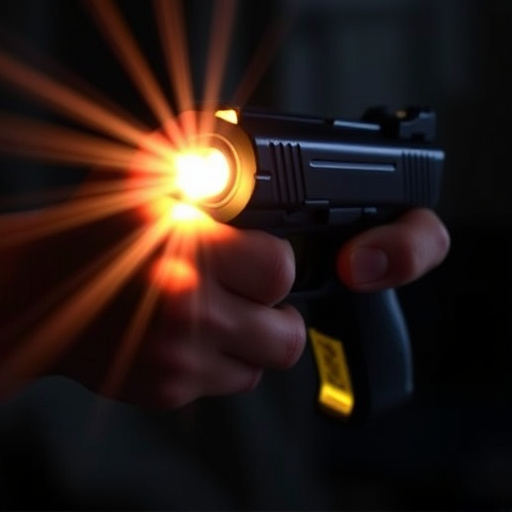A Stun Gun, or Electroshock Weapon (ESW), temporarily incapacitates targets through high-voltage, low-amperage electrical charges, disrupting nerve signals and causing muscle paralysis without penetrating the skin. Amperage strength determines shock severity. Users select stun guns based on protection needs, understanding how they work is crucial. Stun guns carry risks including painful shocks, burns, and rare cardiac arrest, so proper training, safe storage, and following manufacturer guidelines are essential. Global legal regulation of stun guns varies significantly, with many countries implementing age restrictions, training requirements, and specific application scenarios to ensure responsible usage as non-lethal force tools.
“Discover the power behind non-lethal self-defense tools in our comprehensive guide to electrical shock weapons, specifically focusing on amperage. Learn what exactly a stun gun is and how its electric current disrupts muscle control, rendering an assailant unconscious temporarily. We’ll delve into the science behind amperage, explore safety precautions, and navigate legal considerations surrounding these devices. Understanding how stun guns work is crucial for both users and those affected by their application.”
- What is a Stun Gun and How Does It Function?
- Understanding Amperage in Electrical Shock Weapons
- Safety Precautions and Risks Associated with Stun Guns
- Legal Considerations and Regulations for Stun Gun Use
What is a Stun Gun and How Does It Function?
A Stun Gun, also known as an Electroshock Weapon (ESW), is a non-lethal self-defense device designed to incapacitate a target through electrical impulsesthat disrupt the normal functioning of muscle and nerve systems. Unlike traditional firearms that rely on projectiles, stun guns use high-voltage, low-amperage electrical charges to achieve their effect.
The mechanism involves two primary components: an electrical power source and electrodes. When activated, the device delivers a strong electric pulse through the electrodes, which are typically located at the ends of the weapon. This pulse interferes with the nerve signals that control muscle movement, causing temporary paralysis or disorientation in the target. The result is a powerful distraction and incapacitation tool without causing permanent harm or penetration of the skin.
Understanding Amperage in Electrical Shock Weapons
Amperage plays a critical role in understanding the effectiveness of electrical shock weapons, such as stun guns. These devices use electric current to incapacitate a target by disrupting their nervous system temporarily. The amperage, or the amount of electric current flowing through the body, determines the severity of the shock and its impact on the subject.
Knowing how a stun gun works is essential when considering its amperage specifications. Stun guns deliver an electric discharge that travels from the weapon’s electrodes to the target’s skin, passing through their body until it reaches nerves and muscles. The higher the amperage, the more powerful the current, resulting in a stronger muscle contraction and sensory overload, ultimately leading to temporary immobilization. This knowledge is crucial for users to make informed decisions when selecting a stun gun based on their specific needs and desired level of protection.
Safety Precautions and Risks Associated with Stun Guns
Stun guns, also known as electroshock weapons, operate by delivering a powerful electric current through the body of the target. The device uses high-voltage, low-amperage electrical pulses to disrupt muscle control, causing temporary paralysis and disorientation. However, despite their perceived safety compared to firearms, stun guns still carry significant risks and necessitate certain safety precautions.
Users must be aware of the potential for serious injuries, especially if the device is used inappropriately or against resistant targets. Stun guns can cause painful shocks, burns, muscle damage, and in rare cases, even cardiac arrest. Additionally, individuals with medical conditions such as heart problems, seizures, or pacemakers should avoid using stun guns due to the risk of adverse reactions. Always follow manufacturer guidelines, store stun guns safely, and ensure proper training for their use to minimize these risks.
Legal Considerations and Regulations for Stun Gun Use
The use of stun guns, also known as electronic control devices (ECDs), is regulated by various legal frameworks worldwide due to their potential impact on public safety and human rights. These regulations vary significantly from country to country, with some permitting their use exclusively for law enforcement while others allow private citizens to carry them. Understanding the legal landscape surrounding stun guns is essential for both users and authorities alike.
Stun guns operate by delivering a powerful electric shock through a set of electrodes, disrupting the body’s normal muscle function and causing temporary incapacitation. This unique mechanism has sparked debates regarding their use as self-defense tools, especially in civilian contexts. Many jurisdictions have implemented strict guidelines to ensure responsible stun gun ownership, including age restrictions, mandatory training, and specific circumstances under which they can be employed. Regulations also cover the type of current, voltage, and amperage levels permitted, ensuring that stun guns are designed for non-lethal force while still providing effective protection.
Stun guns, or electrical shock weapons, operate by delivering a high-voltage, low-amperage electric current through the body of a target, causing temporary muscular paralysis and disorientation. Understanding amperage is crucial when considering these devices, as it dictates their effectiveness and potential risks. While they are designed for self-defense, users must be aware of safety precautions to minimize harm to themselves and others. Additionally, navigating legal regulations is essential before acquiring or employing a stun gun, ensuring responsible use in accordance with local laws.
